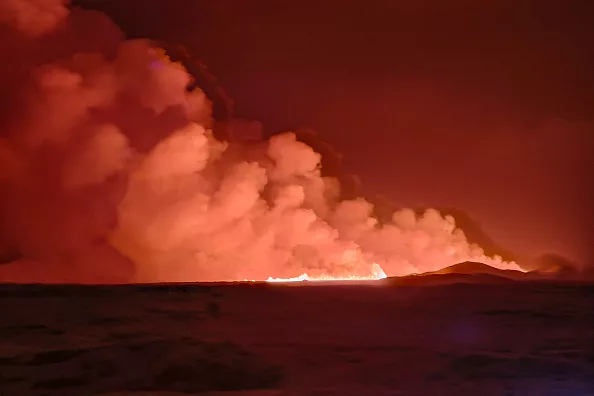An eruption has occurred on the Reykjanes peninsula in southwest Iceland following weeks of heightened earthquake activity. Approximately 4,000 residents were evacuated from the town of Grindavik, and the popular Blue Lagoon geothermal spa was temporarily closed. The Icelandic Met Office reported that the eruption began north of Grindavik at 22:17 local time.

Smoke is billowing as the lava colour the night sky orange from an volcanic eruption on the Reykjanes peninsula 3 km north of Grindavik, western Iceland on December 18, 2023. A volcanic eruption began on Monday night in Iceland, south of the capital Reykjavik, following an earthquake swarm, Iceland’s Meteorological Office reported. (Photo by Kristin Elisabet Gunnarsdottir / AFP) (Photo by KRISTIN ELISABET GUNNARSDOTTIR/AFP via Getty Images)
Unlike the disruptive 2010 eruption that disrupted European air travel, experts believe this event will not cause similar widespread disruption. The seismic activity, which has been increasing since late October in the region around Reykjavik, prompted the evacuation.
The eruption, situated approximately 4km (2.5 miles) northeast of Grindavik, was captured in images and videos on social media shortly after a seismic event. The glow from the eruption was visible in Reykjavik, located about 42km (26 miles) away. Witnesses described half of the sky in the direction of the town as being “lit up in red,” with smoke rising into the air.
Authorities issued warnings for people to stay away from the affected area. The volcanic crack is approximately 3.5km long, with lava flowing at a rate of 100 to 200 cubic meters per second—significantly higher than in recent eruptions on the Reykjanes peninsula.
Iceland’s foreign minister, Bjarni Benediktsson, reassured that there were no flight disruptions to and from Iceland, and international flight corridors remained open. He noted the high jets of lava, indicating a powerful eruption.
While Iceland has been on high alert for a potential eruption, no injuries were reported as of 08:00 GMT. In contrast to the 2010 Eyjafjallajokull eruption, experts believe the current eruption is unlikely to generate similarly massive ash clouds. Volcanologist Dr. Evgenia Ilyinskaya explained that the southwest Icelandic volcanoes lack the capacity for such extensive ash clouds.
Dr. Ilyinskaya, an associate professor of volcanology at Leeds University, emphasized that local communities had been anticipating and fearing the eruption. Authorities were preparing for potential lava flows that could threaten homes and infrastructure, including the iconic Blue Lagoon. Prime Minister Katrin Jakobsdottir expressed hope for the best, citing recent defenses constructed to mitigate the impact. President Gudni Johannesson prioritized safeguarding lives while emphasizing efforts to protect structures in the wake of this significant volcanic event.















